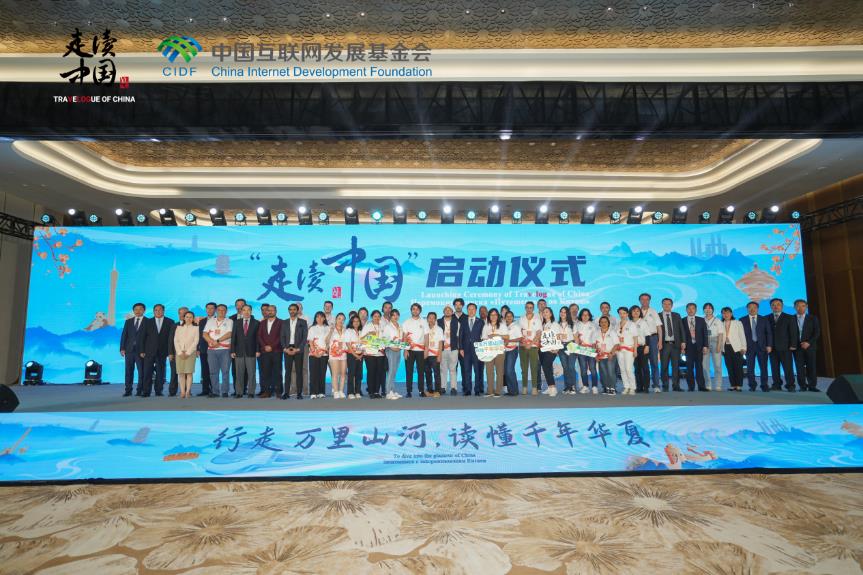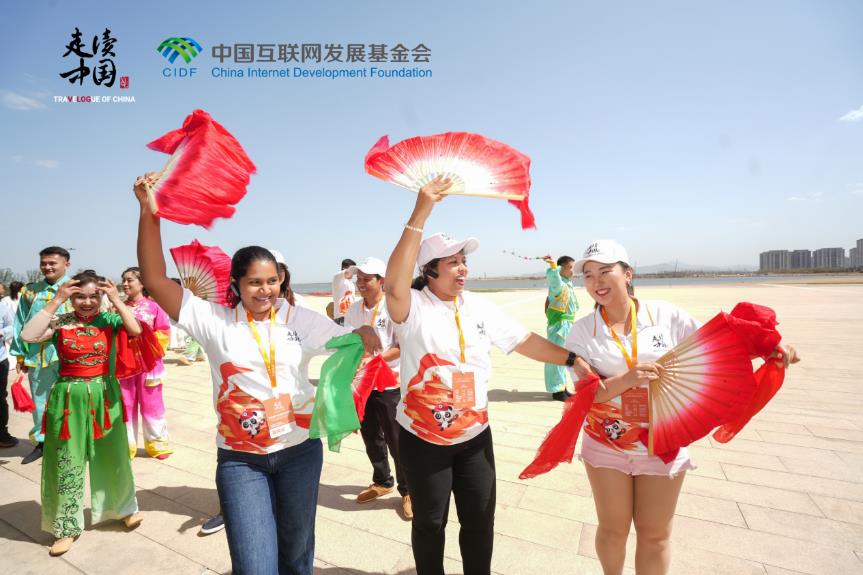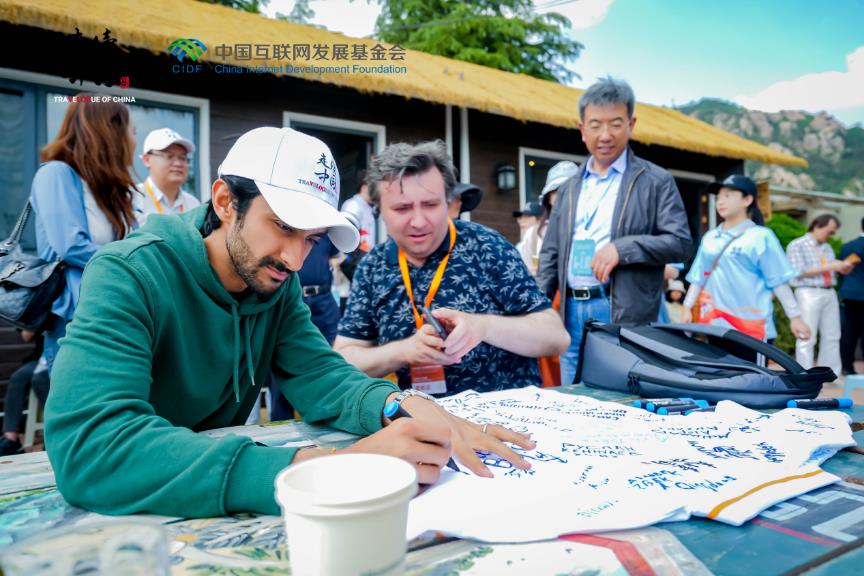Shandong (FN), Jun. 6 – "There were huge differences between certain 'stereotypes' of China and the real China when I arrived and looked at the technological development as most of what you heard came from some Western media, sadly," Rao Abdul Raheem, a journalist from Pakistan, told the Global Times after a recent trip to East China's Shandong Province.
Raheem is one of about 30 foreign journalists from 18 countries, including Kazakhstan, Indonesia, Thailand, Malaysia, and the Solomon Islands, who recently made a trip to Shandong to learn about China's economic development and culture.
The international media exchange program, "Travelogue of China," was guided by the Cyber Communication Bureau under the Cyberspace Administration of China, and hosted by the China Public Diplomacy Association and the Global Times Online, supported by China Internet Development Foundation.
During the weeklong trip starting from May 21 to various cities in Shandong, these foreign journalists visited China's high-tech manufacturing companies in Qingdao, modern agricultural planting centers in Weifang, and Chinese cultural relics in Jining, and shared their point of views about industry development and international cooperation.
Smart manufacturing hub
The journalists first arrived in Qingdao, a major hub for high-end manufacturing in China. The first stop was the CRRC Qingdao Sifang Co, the birth place of China's Fuxing High-speed Electric Multiple Unit (EMU) train, the world's fastest commercial train at a speed of 350 kilometers per hour.
Stepping into the assembly workshop, multiple orange-colored CR400AF-Z EMU trains, also known as the Fuxing bullet train, were lined up in an orderly fashion, sparking palpable interest and enthusiasm among the journalists.
A whole set of Fuxing bullet trains is made up of eight coaches, containing over 550,000 individual parts, and can be assembled by the CRRC Qingdao Sifang Co with the maximum speed of six coaches per day, the Global Times learned from the company.
At present, CRRC Qingdao Sifang Co has made over 1,600 EMU trains for domestic and international markets, serving clients in 28 countries and regions worldwide. In 2021, the "Lancang" EMU manufactured by the company was brought into service on the China-Laos Railway, helping Laos transform from a "land-locked" country to a "land-linked" country in the region.
Khamphone Syvongxay, a journalist from Laos, told the Global Times during his visit at the CRRC Qingdao Sifang Co that he once experienced the "Lancang" EMU on the Lao side of China-Laos Railway, which has gained popularity among Lao people.
"The high-speed EMU trains can shorten the travel times between stops along the railway, reduce the cost for cargo and passenger transport, and also enhance foreign trade between Laos and China," he said.
The CRRC Qingdao Sifang Co also designed and manufactured high-speed EMUs with a maximum operating speed of 350 kilometers per hour for the Jakarta-Bandung High-speed Railway in Indonesia, which will cut the travel times of the 142.3-kilometer-railway from the current three hours to just 40 minutes, greatly improving local traffic conditions and boosting economic and social development along the route.
Indonesian journalist Elsa Emiria Leba said the high-speed EMU trains now on the Jakarta-Bandung High-speed Railway are called the "Red Komodo" by Indonesian people because of their red and silver coating, and an abstract pattern of a dragon, which have gone viral on Indonesian social media platforms.
Since the official start of construction of the Jakarta-Bandung High-speed Railway on 9 June 2018, the construction of the project has progressed smoothly. Debugging and testing of the Jakarta-Bandung High-Speed Railway began on May 22, a landmark project under the China-proposed Belt and Road Initiative (BRI). It marked an important milestone before the full launch of the project.
The journalists also visited Chinese famous home appliance maker Haier, which was established in Qingdao in 1984. The exhibition hall of Haier's history witnesses how the company has grown to an international manufacturing giant through multiple challenges and difficulties.
Zhang Ruimin, first chairman of Haier, sets strict rules of quality control. Zhang once gathered all senior officers of the company together, and smashed defective washing machine with a hammer in public to warn of the importance of quality control, even though it was China's developing period of lacking any kind of resources.
"I was deeply impressed by the spirit of chairman of Haier and all of the workers of Haier," said Luke Mani, a journalist from the Solomon Islands.
He noted that the global home appliance market is under fierce competition among over 40 brands and most of them are from Japan, the US, and other developed countries. "It was a remarkable success for a Chinese company to grow to world leading position from a relatively low level in technology, which further clarifies my imagination of Chinese people's determination," he said.
As one of the first batch of Chinese cities that carried out industrialization, the manufacturing gene of Qingdao has been inherited for over a century. The coastal city is now eyeing the next technology and industry revolution, and is further pushing the local manufacturing sector into a high-end oriented development mechanism, as well as being more intelligent and sustainable.
Seeds of gold
The second stop was in Shouguang in Weifang, known for its local advanced agricultural industry and vegetable output, which has over 200,000 vegetable greenhouses and a planting area of nearly 600,000 mu (40,000 hectares) , making the city the origin of greenhouse vegetable planting technique in China.
Shouguang is also one of China's largest vegetable transport hubs. On average, more than 17,000 kilograms of vegetable are sold per minute to cities across the country.
At the Danhe Greenhouse Vegetable Standardized Planting Park, the journalist group was introduced to whole sets of intelligent planting systems including temperature adjustors and intelligent irrigators, which can be easily controlled via workers' portable devices such as laptops or smartphones.
Thanks to a series of advanced planting facilities, Danhe Planting Park has bred over 200 new mini tomato varieties, most of which are the intellectual property of the planting park. "In order to secure China's food security, we have built the largest germplasm protection center in Shandong Province and facilitated 178 locally developed vegetable varieties, taking over 70 percent of Shouguang's vegetable market share," said the representative from the planting park.
When visiting the vegetable tasting area, the journalists were shocked by numerous kinds of vegetables being exhibited on shelves, and were also impressed by their taste.
"This is amazing! My country has so many kinds of vegetable but not as varied and tasty as this! How did they do this?" Flordeliza Tabilog Agoot, a journalist from the Philippines asked during her visit.
What made the journalists more curious was where the vegetables would be sold, what mode of transportation would be used, and how it would affect the income of local farmers. Officials from the local government revealed to the journalist group that a series of supportive measures are granted to vegetable farmers in order to secure the high-quality operation of the national vegetable hub.
"In the transport sector, we remove the highway tolls for vehicles transporting vegetable. The operation of local greenhouse will be paused during June to August, the hottest period in a year, in order to protect the soil from insects through high temperatures and achieve sustainable development," said official from local government.
Boosted by a sophisticated vegetable industry chain, almost every family working in vegetable planting has two cars, one for family use and one for transporting cargo. Each family usually operates three greenhouses for planting vegetables, each greenhouse can generate 100,000 yuan (USD14,121) of income annually, said the official.
Shouguang's companies in the agricultural sector are also exploring a new approach to breaking the limit of soil and climate. A portable vegetable planting unit transformed by container developed by the Xiangtian Agricultural Technology Co, can realize vegetable planting in various climate conditions.
"An intelligent controlling system inside the planting unit can imitate a real natural environment, achieving continuous and stable vegetable output in various locations in the world," said the staff member from the company. He noted that the vegetable output of each portable planting unit is equivalent to the output of 2 mu of planting field.
The portable planting unit can generate about 600,000 yuan of profit each year, and now has been exported overseas to Japan, Canada, Bulgaria, and United Arab Emirates.
After the journey in Shouguang, Purushottam Poudel, the assistant senior deputy editor-in-chief of Kathmandu Post form Nepal, suggested that he would like to introduce Nepalese agricultural institutions to study in Shouguang and establish contact with local officials.
Flordeliza Tabilog Agoot praised the seeds protection and vegetable planting facilities of Shouguang, and was also impressed by the local government's efforts in technological innovation, granting financial support, and improving people's living standards.
Bridge for cultural exchanges
Before the opening ceremony of the "Travelogue of China," a group of local artists who have mastered intangible cultural heritages including traditional paper cutting, embroidery, tea art, and calligraphy were gathered at the Qingdao SCODA Pearl International Expo Center, and showed remarkable skills in art to the journalists.
During the exhibition, Ruslan Kenjaev, the deputy editor-in-chief of Uzbekistani press Xalq so'zi, told the Global Times that China has a profound history, culture, and ancient relics. "Everyone should visit China once in their life."
Jining was the birthplace of Confucius, and was chosen as the last stop of the journey in Shandong. Some foreign journalists spoke of the Analects of Confucius because of the great international influence of the ancient Chinese philosopher.
"In fact, the cultural difference between us is not as big as some had imagined," said Cambodian journalist Chea Thyrith. "There are Confucius Institutes in Cambodia, and some Chinese cultural symbols such as the Journey to the West and documentaries about ancient Chinese history, which are also popular in Cambodia."
Chen Renze, an official from the Cyberspace Administration of China, pointed out that friendship, which is derived from close contact between people, holds the key to sound state-to-state relations, and the communication between the journalist group and Chinese culture is the bridge linking countries together.
"I have read a lot about countries like Singapore, Japan, Chile, and traveled to many countries. But China interests me the most. China is not only a country, but also a civilization with a culture and traditions that have been passed down for thousands of years. The wisdom of the Chinese people always impresses me," Mani from the Solomon Islands said.
He said that after returning to his country, he will introduce Chinese technology and Chinese culture to the people of the Solomon Islands, and let them learn about the wisdom and innovative spirit of the Chinese people.
Such concrete steps toward building bridges for cultural exchanges are indeed the spirit of the "Travelogue of China."
=FRESH NEWS




